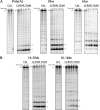The RNase R from Campylobacter jejuni has unique features and is involved in the first steps of infection
- PMID: 25100732
- PMCID: PMC4183816
- DOI: 10.1074/jbc.M114.561795
The RNase R from Campylobacter jejuni has unique features and is involved in the first steps of infection
Abstract
Bacterial pathogens must adapt/respond rapidly to changing environmental conditions. Ribonucleases (RNases) can be crucial factors contributing to the fast adaptation of RNA levels to different environmental demands. It has been demonstrated that the exoribonuclease polynucleotide phosphorylase (PNPase) facilitates survival of Campylobacter jejuni in low temperatures and favors swimming, chick colonization, and cell adhesion/invasion. However, little is known about the mechanism of action of other ribonucleases in this microorganism. Members of the RNB family of enzymes have been shown to be involved in virulence of several pathogens. We have searched C. jejuni genome for homologues and found one candidate that displayed properties more similar to RNase R (Cj-RNR). We show here that Cj-RNR is important for the first steps of infection, the adhesion and invasion of C. jejuni to eukaryotic cells. Moreover, Cj-RNR proved to be active in a wide range of conditions. The results obtained lead us to conclude that Cj-RNR has an important role in the biology of this foodborne pathogen.
Keywords: Adhesion; Campylobacter; Foodborne Pathogen; Invasion; RNA Catalysis; RNA Metabolism; Ribonuclease.
© 2014 by The American Society for Biochemistry and Molecular Biology, Inc.
Figures











Similar articles
-
Biochemical characterization of Campylobacter jejuni PNPase, an exoribonuclease important for bacterial pathogenicity.Biochimie. 2018 Apr;147:70-79. doi: 10.1016/j.biochi.2018.01.001. Epub 2018 Jan 13. Biochimie. 2018. PMID: 29339148
-
Polynucleotide phosphorylase has an impact on cell biology of Campylobacter jejuni.Front Cell Infect Microbiol. 2012 Mar 14;2:30. doi: 10.3389/fcimb.2012.00030. eCollection 2012. Front Cell Infect Microbiol. 2012. PMID: 22919622 Free PMC article.
-
Characterization of the biochemical properties of Campylobacter jejuni RNase III.Biosci Rep. 2013 Nov 25;33(6):e00082. doi: 10.1042/BSR20130090. Biosci Rep. 2013. PMID: 24073828 Free PMC article.
-
Polyphosphate and associated enzymes as global regulators of stress response and virulence in Campylobacter jejuni.World J Gastroenterol. 2016 Sep 7;22(33):7402-14. doi: 10.3748/wjg.v22.i33.7402. World J Gastroenterol. 2016. PMID: 27672264 Free PMC article. Review.
-
Campylobacter jejuni: molecular biology and pathogenesis.Nat Rev Microbiol. 2007 Sep;5(9):665-79. doi: 10.1038/nrmicro1718. Nat Rev Microbiol. 2007. PMID: 17703225 Review.
Cited by
-
Hibernation-Promoting Factor Sequesters Staphylococcus aureus Ribosomes to Antagonize RNase R-Mediated Nucleolytic Degradation.mBio. 2021 Aug 31;12(4):e0033421. doi: 10.1128/mBio.00334-21. Epub 2021 Jul 13. mBio. 2021. PMID: 34253058 Free PMC article.
-
The Role of Ribonucleases and sRNAs in the Virulence of Foodborne Pathogens.Front Microbiol. 2017 May 19;8:910. doi: 10.3389/fmicb.2017.00910. eCollection 2017. Front Microbiol. 2017. PMID: 28579982 Free PMC article. Review.
-
VapD in Xylella fastidiosa Is a Thermostable Protein with Ribonuclease Activity.PLoS One. 2015 Dec 22;10(12):e0145765. doi: 10.1371/journal.pone.0145765. eCollection 2015. PLoS One. 2015. PMID: 26694028 Free PMC article.
-
How hydrolytic exoribonucleases impact human disease: Two sides of the same story.FEBS Open Bio. 2023 Jun;13(6):957-974. doi: 10.1002/2211-5463.13392. Epub 2022 Mar 20. FEBS Open Bio. 2023. PMID: 35247037 Free PMC article. Review.
-
RNase R is associated in a functional complex with the RhpA DEAD-box RNA helicase in Helicobacter pylori.Nucleic Acids Res. 2021 May 21;49(9):5249-5264. doi: 10.1093/nar/gkab283. Nucleic Acids Res. 2021. PMID: 33893809 Free PMC article.
References
-
- Ruiz-Palacios G. M. (2007) The health burden of Campylobacter infection and the impact of antimicrobial resistance: playing chicken. Clin. Infect. Dis. 44, 701–703 - PubMed
-
- Riddle M. S., Gutierrez R. L., Verdu E. F., Porter C. K. (2012) The chronic gastrointestinal consequences associated with Campylobacter. Curr. Gastroenterol. Rep. 14, 395–405 - PubMed
Publication types
MeSH terms
Substances
LinkOut - more resources
Full Text Sources
Other Literature Sources
Medical

